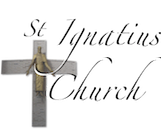
God’s Hands Writing History
Have you seen the many posters lined up all over the church premises announcing the 25th Anniversary of the Dedication of the Present Church? If you look closer, they contain an outline of the Schedule of Events in various languages. But is our church “that young”? For those who have been coming to St. Ignatius Church for more than 25 years, they will definitely say,” NO!” It has a history that goes back 75 years!

In this issue of the Bulletin, we would like to share with you the history of St. Ignatius Church as outlined by our present pastor, Fr. Toshiaki Koso SJ, in his Sunday homily April 21, 2024. The original text was in Japanese and below are some excerpts:
Today marks the 75th anniversary of the birth of our St. Ignatius Church. On Easter Sunday April 17, 1949, a solemn Mass to dedicate the church was celebrated by Archbishop Tatsuo Doi. But this church actually dates back to the Kōjimachi Parish Church of St. Thérèse of the Child Jesus, established 88 years ago in 1936 and located in 6-Banchō, down beyond Futaba Gakuen on a site vacated by a Carmelite monastery which had moved to Nerima.
In 1945, towards the end World War II, Tokyo experienced massive air raids. Not only the Church of St. Thérèse but also the residences in this area, where we are now, were all burnt down. In the meantime, Mass was held inside Sophia University.
Interesting questions arise. Why did the church become St. Ignatius Church? Why was it possible to build a church in such a prime location within the outer moat of the Imperial Palace? How was it possible to build such a large church so soon after Japan’s defeat, when supplies were scarce?
Around that time, funds for rebuilding churches that had been burned down arrived from the Vatican, but Archbishop Paulo Marella, the Vatican ambassador to Japan at the time, suggested to Archbishop Doi that the funds received be used to rebuild other churches and leave the rebuilding of Kōjimachi Church (with approximately 1,200 members) to the Society of Jesus. Fr Bruno Bitter, the financial administrator of the Society of Jesus at the time, accepted this proposal and declared that he would definitely build a church suitable for the new era. They also had to look for a new location.
The Jesuits negotiated with various landowners in the Kōjimachi area and acquired a property measuring 7,300 tsubo. It is said that there was also a Shiratama Inari shrine located right at our present Main Gate. According to old records, this shrine is said to be the Ii family's guardian deity, but it was burnt down in the air raid. When the Jesuits negotiated with them, the manager, who was a very good man, gave the land saying “Western gods will live in place of Japanese gods.''
On May 12, 1948, while construction was underway, a letter arrived from the Holy See declaring that the new church being built be given the privilege of being a “permanent religious parish,” that is, a parish church entrusted to a religious order, the Society of Jesus, for an indefinite period of time.
On August 8, 1948, the groundbreaking ceremony was held. The design director was Jesuit Brother Ignatius Gropper. On April 17, 1949, Kōjimachi Church, now re-named St. Ignatius Church, was born. The church was referred to as a "giant wooden ship." It was as high as a 3-story building and was made of wood and mortar. Records show that the large pieces of wood used in the beams were ordered from Canada. The main altar and side altars made of beautiful white marble, were donated by believers from Brooklyn, New York. There were seven stained glass windows above the altar of the church (now located in the stairwell leading down to the crypt), other stained glass figures (now lined up behind the crypt altar), and the large stained glass window of Ignatius (now in the St Mary’s Chapel)--all gifts from Belgium. The large bells that still ring came from a German company, the president of which was the brother of Fr Hermann Heuvers, the first Pastor of St. Ignatius Church. He had decided to collect iron materials his company had used to make weapons of war and make them instruments for peace, instead.
Fr. Koso concluded: As we look back on the history of our church, we realize that it has been multinational from the beginning, and that many people in the Catholic world have contributed to St. Ignatius church. Thanks to their goodwill and support, we are now able to celebrate our 75th and 25th anniversaries. In all of this, we can sense God's mercy and plan. So, I would like to repeat today's Responsorial Psalm: “Today is the day God has made, so let's sing joyfully and share this day together!''
By Sr. Flor Florece, F.I.
 ENGLISH
ENGLISH  ESPAÑOL
ESPAÑOL 





